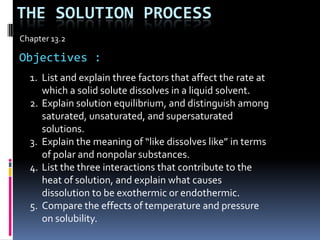Chapter 13.2 : The Solution Process
•Transferir como PPTX, PDF•
5 gostaram•7,457 visualizações
Denunciar
Compartilhar
Denunciar
Compartilhar

Recomendados
Recomendados
Mais conteúdo relacionado
Mais procurados
Mais procurados (20)
Destaque (20)
LTMS 510: Learning Technologies and Solutions - Class 12

LTMS 510: Learning Technologies and Solutions - Class 12
Semelhante a Chapter 13.2 : The Solution Process
Semelhante a Chapter 13.2 : The Solution Process (20)
Dacota_blue K12: Science 7: Quarter 1: Module 1 matter

Dacota_blue K12: Science 7: Quarter 1: Module 1 matter
General Chemistry 2 Q1L4 Solutions properties.pptx

General Chemistry 2 Q1L4 Solutions properties.pptx
Mais de Chris Foltz
Mais de Chris Foltz (20)
Último
“Oh GOSH! Reflecting on Hackteria's Collaborative Practices in a Global Do-It...

“Oh GOSH! Reflecting on Hackteria's Collaborative Practices in a Global Do-It...Marc Dusseiller Dusjagr
Último (20)
Interactive Powerpoint_How to Master effective communication

Interactive Powerpoint_How to Master effective communication
Separation of Lanthanides/ Lanthanides and Actinides

Separation of Lanthanides/ Lanthanides and Actinides
Kisan Call Centre - To harness potential of ICT in Agriculture by answer farm...

Kisan Call Centre - To harness potential of ICT in Agriculture by answer farm...
“Oh GOSH! Reflecting on Hackteria's Collaborative Practices in a Global Do-It...

“Oh GOSH! Reflecting on Hackteria's Collaborative Practices in a Global Do-It...
Industrial Policy - 1948, 1956, 1973, 1977, 1980, 1991

Industrial Policy - 1948, 1956, 1973, 1977, 1980, 1991
Measures of Central Tendency: Mean, Median and Mode

Measures of Central Tendency: Mean, Median and Mode
TataKelola dan KamSiber Kecerdasan Buatan v022.pdf

TataKelola dan KamSiber Kecerdasan Buatan v022.pdf
Hybridoma Technology ( Production , Purification , and Application ) 

Hybridoma Technology ( Production , Purification , and Application )
Chapter 13.2 : The Solution Process
- 1. The solution process Chapter 13.2 Objectives : List and explain three factors that affect the rate at which a solid solute dissolves in a liquid solvent. Explain solution equilibrium, and distinguish among saturated, unsaturated, and supersaturated solutions. Explain the meaning of “like dissolves like” in terms of polar and nonpolar substances. List the three interactions that contribute to the heat of solution, and explain what causes dissolution to be exothermic or endothermic. Compare the effects of temperature and pressure on solubility.
- 2. Factors Affecting the Rate of Dissolution Increasing the surface area of the solute Sugar cube will dissolve slower than ground up sugar Agitating a solution Stir your iced tea and the sugar will dissolve faster. Heating a Solvent Sugar dissolves faster in hot tea
- 3. Solubility Solution equilibrium Physical state in which the opposing processes of dissolution and crystallization of a solute occur at equal rates. Saturated solution Solution that contains the maximum amount of dissolved solute Example: At 20oC, 35.9 g of NaCl is the maximum amount that will dissolve in 100. g of water Unsaturated solution Solution that contains less solute than a saturated solution under existing conditions
- 4. Supersaturated solutions Solution that contains more dissolved solute than a saturated solution contains under the same conditions. Disturbing solution will cause rapid crystallization Video demonstration 1 Video demonstration 2 Solvent : water Solute : glucose
- 5. Solute-Solvent Interactions “Like dissolves Like” Polar will dissolve polar Nonpolar will dissolve nonpolar Polar will NOT dissolve in nonpolar Dissolving ionic compounds in aqueous solutions Hydration : solution process with water as the solvent CuSO4•5H2O - hydrate Crystalline compounds that incorporate water molecules
- 6. Nonpolar solvents Carbon tetrachloride and toluene Substances similar to oil Liquid solutes and solvents Immiscible LIQUID solutes and solvents that are not soluble in each other Example: oil and vinegar Miscible Liquids that dissolve freely in one another in any proportions Ethanol and water
- 7. Effects of Pressure on Solubility Increase in pressure – increases gas solubilities in liquids gas + solvent solution Henry’s Law Solubility of a gas in a liquid is directly proportional to the partial pressure of that gas on the surface of the liquid. Effervescence Rapid escape of a gas from a liquid in which it is dissolved Mentos demo
- 8. Effects of Temperature on Solubility For gaseoussolutes Increase in temperature Decrease in solubility For solid solutes Increase in temperature Increase in solubility